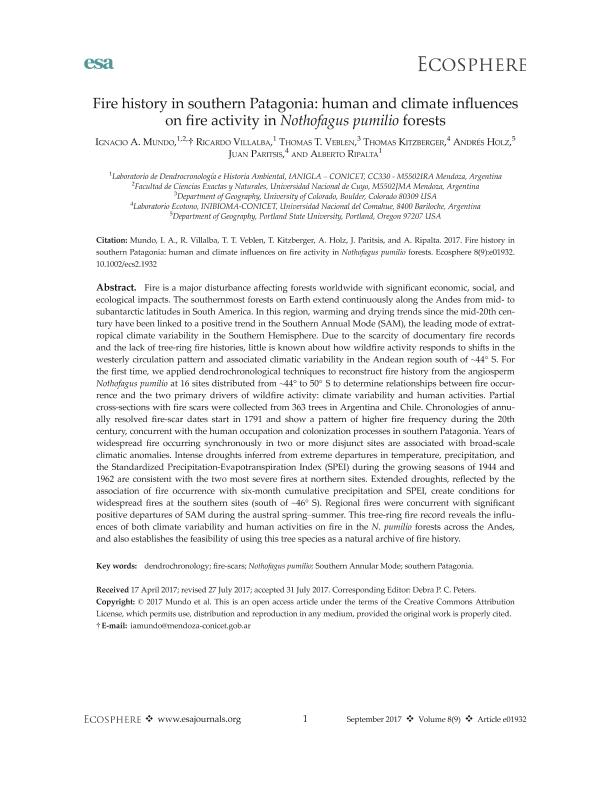Mostrar el registro sencillo del ítem
dc.contributor.author
Mundo, Ignacio Alberto

dc.contributor.author
Villalba, Ricardo

dc.contributor.author
Veblen, Thomas

dc.contributor.author
Kitzberger, Thomas

dc.contributor.author
Holz, Andrés
dc.contributor.author
Paritsis, Juan

dc.contributor.author
Ripalta, Alberto

dc.date.available
2018-01-02T18:45:52Z
dc.date.issued
2017-09
dc.identifier.citation
Ripalta, Alberto; Paritsis, Juan; Holz, Andrés; Kitzberger, Thomas; Veblen, Thomas; Villalba, Ricardo; et al.; Fire history in southern Patagonia: human and climate influences on fire activity in Nothofagus pumilio forests; Wiley; Ecosphere; 8; 9; 9-2017; 1-23
dc.identifier.issn
2150-8925
dc.identifier.uri
http://hdl.handle.net/11336/32016
dc.description.abstract
Fire is a major disturbance affecting forests worldwide with significant economic, social, and ecological impacts. The southernmost forests on Earth extend continuously along the Andes from mid- to subantarctic latitudes in South America. In this region, warming and drying trends since the mid-20th century have been linked to a positive trend in the Southern Annual Mode (SAM), the leading mode of extratropical climate variability in the Southern Hemisphere. Due to the scarcity of documentary fire records and the lack of tree-ring fire histories, little is known about how wildfire activity responds to shifts in the westerly circulation pattern and associated climatic variability in the Andean region south of ~44° S. For the first time, we applied dendrochronological techniques to reconstruct fire history from the angiosperm Nothofagus pumilio at 16 sites distributed from ~44° to 50° S to determine relationships between fire occurrence and the two primary drivers of wildfire activity: climate variability and human activities. Partial cross-sections with fire scars were collected from 363 trees in Argentina and Chile. Chronologies of annually resolved fire-scar dates start in 1791 and show a pattern of higher fire frequency during the 20th century, concurrent with the human occupation and colonization processes in southern Patagonia. Years of widespread fire occurring synchronously in two or more disjunct sites are associated with broad-scale climatic anomalies. Intense droughts inferred from extreme departures in temperature, precipitation, and the Standardized Precipitation-Evapotranspiration Index (SPEI) during the growing seasons of 1944 and 1962 are consistent with the two most severe fires at northern sites. Extended droughts, reflected by the association of fire occurrence with six-month cumulative precipitation and SPEI, create conditions for widespread fires at the southern sites (south of ~46° S). Regional fires were concurrent with significant positive departures of SAM during the austral spring?summer. This tree-ring fire record reveals the influences of both climate variability and human activities on fire in the N. pumilio forests across the Andes, and also establishes the feasibility of using this tree species as a natural archive of fire history.
dc.format
application/pdf
dc.language.iso
eng
dc.publisher
Wiley

dc.rights
info:eu-repo/semantics/openAccess
dc.rights.uri
https://creativecommons.org/licenses/by/2.5/ar/
dc.subject
Dendrochronology
dc.subject
Fire-Scars
dc.subject
Nothofagus Pumilio
dc.subject
Southern Annular Mode
dc.subject
Southern Patagonia
dc.subject.classification
Otras Ciencias Biológicas

dc.subject.classification
Ciencias Biológicas

dc.subject.classification
CIENCIAS NATURALES Y EXACTAS

dc.title
Fire history in southern Patagonia: human and climate influences on fire activity in Nothofagus pumilio forests
dc.type
info:eu-repo/semantics/article
dc.type
info:ar-repo/semantics/artículo
dc.type
info:eu-repo/semantics/publishedVersion
dc.date.updated
2017-12-15T14:31:54Z
dc.journal.volume
8
dc.journal.number
9
dc.journal.pagination
1-23
dc.journal.pais
Estados Unidos

dc.journal.ciudad
Hoboken
dc.description.fil
Fil: Mundo, Ignacio Alberto. Consejo Nacional de Investigaciones Científicas y Técnicas. Centro Científico Tecnológico Conicet - Mendoza. Instituto Argentino de Nivología, Glaciología y Ciencias Ambientales. Provincia de Mendoza. Instituto Argentino de Nivología, Glaciología y Ciencias Ambientales. Universidad Nacional de Cuyo. Instituto Argentino de Nivología, Glaciología y Ciencias Ambientales; Argentina. Consejo Nacional de Investigaciones Científicas y Técnicas. Laboratorio de Dendrocronología e Historia Ambiental; Argentina. Universidad Nacional de Cuyo. Facultad de Ciencias Exactas y Naturales; Argentina
dc.description.fil
Fil: Villalba, Ricardo. Consejo Nacional de Investigaciones Científicas y Técnicas. Centro Científico Tecnológico Conicet - Mendoza. Instituto Argentino de Nivología, Glaciología y Ciencias Ambientales. Provincia de Mendoza. Instituto Argentino de Nivología, Glaciología y Ciencias Ambientales. Universidad Nacional de Cuyo. Instituto Argentino de Nivología, Glaciología y Ciencias Ambientales; Argentina
dc.description.fil
Fil: Veblen, Thomas. State University of Colorado Boulder; Estados Unidos
dc.description.fil
Fil: Kitzberger, Thomas. Consejo Nacional de Investigaciones Científicas y Técnicas. Centro Científico Tecnológico Conicet - Patagonia Norte. Instituto de Investigaciones en Biodiversidad y Medioambiente. Universidad Nacional del Comahue. Centro Regional Universidad Bariloche. Instituto de Investigaciones en Biodiversidad y Medioambiente; Argentina. Universidad Nacional del Comahue. Centro Regional Universitario Bariloche. Laboratorio de Ecotono; Argentina
dc.description.fil
Fil: Holz, Andrés. Portland State University. Department of Geography; Estados Unidos
dc.description.fil
Fil: Paritsis, Juan. Consejo Nacional de Investigaciones Científicas y Técnicas. Centro Científico Tecnológico Conicet - Patagonia Norte. Instituto de Investigaciones en Biodiversidad y Medioambiente. Universidad Nacional del Comahue. Centro Regional Universidad Bariloche. Instituto de Investigaciones en Biodiversidad y Medioambiente; Argentina. Universidad Nacional del Comahue. Centro Regional Universitario Bariloche. Laboratorio de Ecotono; Argentina
dc.description.fil
Fil: Ripalta, Alberto. Universidad Nacional de Cuyo. Facultad de Ciencias Exactas y Naturales; Argentina. Consejo Nacional de Investigaciones Científicas y Técnicas. Laboratorio de Dendrocronología e Historia Ambiental; Argentina. Consejo Nacional de Investigaciones Científicas y Técnicas. Centro Científico Tecnológico Conicet - Mendoza. Instituto Argentino de Nivología, Glaciología y Ciencias Ambientales. Provincia de Mendoza. Instituto Argentino de Nivología, Glaciología y Ciencias Ambientales. Universidad Nacional de Cuyo. Instituto Argentino de Nivología, Glaciología y Ciencias Ambientales; Argentina
dc.journal.title
Ecosphere
dc.relation.alternativeid
info:eu-repo/semantics/altIdentifier/url/http://onlinelibrary.wiley.com/doi/10.1002/ecs2.1932/abstract
dc.relation.alternativeid
info:eu-repo/semantics/altIdentifier/doi/http://dx.doi.org/10.1002/ecs2.1932
Archivos asociados
